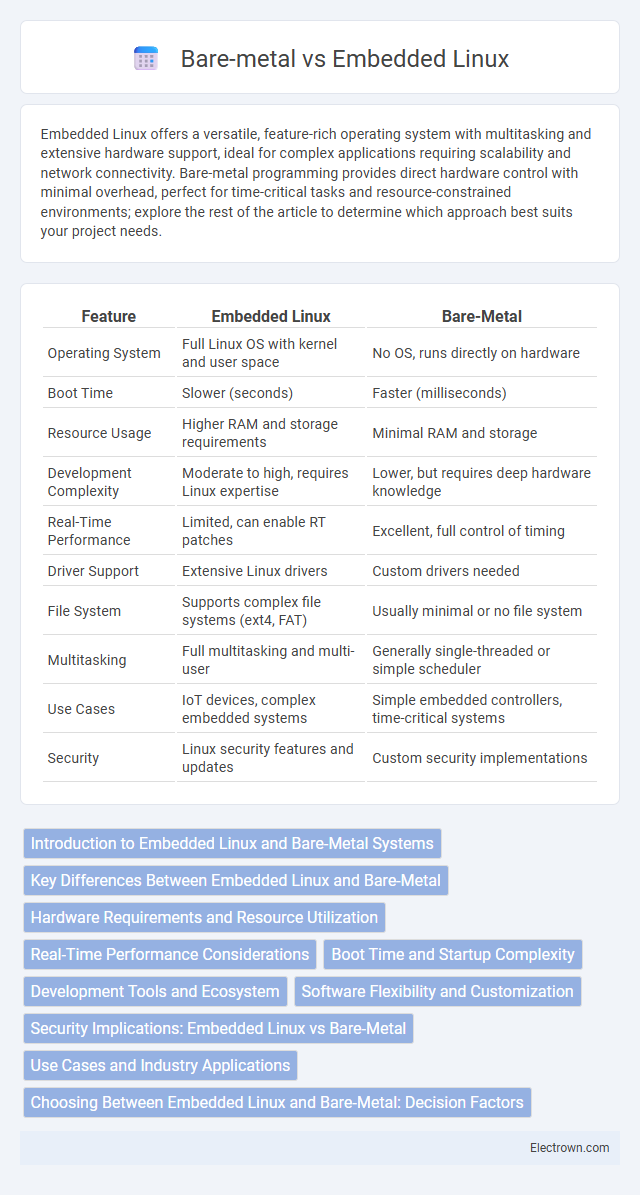Embedded Linux offers a versatile, feature-rich operating system with multitasking and extensive hardware support, ideal for complex applications requiring scalability and network connectivity. Bare-metal programming provides direct hardware control with minimal overhead, perfect for time-critical tasks and resource-constrained environments; explore the rest of the article to determine which approach best suits your project needs.
Table of Comparison
| Feature | Embedded Linux | Bare-Metal |
|---|---|---|
| Operating System | Full Linux OS with kernel and user space | No OS, runs directly on hardware |
| Boot Time | Slower (seconds) | Faster (milliseconds) |
| Resource Usage | Higher RAM and storage requirements | Minimal RAM and storage |
| Development Complexity | Moderate to high, requires Linux expertise | Lower, but requires deep hardware knowledge |
| Real-Time Performance | Limited, can enable RT patches | Excellent, full control of timing |
| Driver Support | Extensive Linux drivers | Custom drivers needed |
| File System | Supports complex file systems (ext4, FAT) | Usually minimal or no file system |
| Multitasking | Full multitasking and multi-user | Generally single-threaded or simple scheduler |
| Use Cases | IoT devices, complex embedded systems | Simple embedded controllers, time-critical systems |
| Security | Linux security features and updates | Custom security implementations |
Introduction to Embedded Linux and Bare-Metal Systems
Embedded Linux is a versatile operating system tailored for resource-constrained devices, offering multitasking, rich networking, and extensive driver support, making it ideal for complex embedded applications. Bare-metal systems run directly on hardware without an underlying OS, delivering minimal latency and maximum control, which is crucial for real-time and safety-critical tasks. Your choice depends on your project's complexity, performance requirements, and the need for features like networking or file systems.
Key Differences Between Embedded Linux and Bare-Metal
Embedded Linux offers a full-featured operating system with multitasking, memory management, and driver support, enabling complex applications and easier development. Bare-metal programming runs directly on the hardware without an OS, providing minimal latency, deterministic performance, and lower resource usage for critical, real-time applications. Your choice depends on the need for system complexity, performance constraints, and development flexibility in your embedded project.
Hardware Requirements and Resource Utilization
Embedded Linux requires more robust hardware including higher RAM and storage capacities compared to bare-metal systems, which operate efficiently on minimal resources due to the absence of an operating system. Resource utilization in Embedded Linux involves higher CPU cycles and power consumption because of multitasking and kernel overhead, whereas bare-metal applications directly manage hardware, leading to lower latency and energy use. Choosing between Embedded Linux and bare-metal depends on hardware constraints, where Linux suits complex applications demanding advanced features, and bare-metal excels in resource-limited, real-time environments.
Real-Time Performance Considerations
Embedded Linux offers robust real-time performance through real-time patches like PREEMPT_RT and support for real-time scheduling, making it suitable for complex applications requiring multitasking and networking. Bare-metal systems provide the highest deterministic response times by running directly on hardware without an operating system, minimizing latency and jitter crucial for time-critical applications. Your choice depends on whether your project prioritizes raw real-time control with minimal overhead or needs advanced OS features alongside reasonable real-time capabilities.
Boot Time and Startup Complexity
Embedded Linux offers longer boot times compared to bare-metal systems due to its complex kernel initialization and extensive driver loading processes. Bare-metal environments provide near-instant startup by running directly on hardware without an operating system, minimizing boot overhead and simplifying startup sequences. For applications requiring fast boot performance with minimal configuration, your choice leans toward bare-metal solutions.
Development Tools and Ecosystem
Embedded Linux offers a rich development ecosystem with tools such as Yocto, Buildroot, and OpenEmbedded, enabling custom OS builds and extensive driver support. Bare-metal development relies on simpler toolchains like GCC, Keil, or IAR, focusing on direct hardware access with minimal overhead but limited ecosystem resources. Your choice impacts debugging capabilities and community support, with Embedded Linux providing more comprehensive tools and libraries for complex applications.
Software Flexibility and Customization
Embedded Linux offers extensive software flexibility and customization due to its rich ecosystem, support for multiple programming languages, and modular architecture that enables developers to add or remove components as needed. Bare-metal programming provides low-level hardware access and minimal overhead, allowing for precise control but limited adaptability and fewer built-in software features. The choice between Embedded Linux and bare-metal hinges on the project's requirements for scalability, real-time performance, and software complexity.
Security Implications: Embedded Linux vs Bare-Metal
Embedded Linux offers robust security features including built-in user authentication, advanced access control mechanisms, and regular security updates, which significantly reduce vulnerability exposure. Bare-metal systems provide a smaller attack surface due to minimal software layers but lack inherent security frameworks, making them reliant on custom implementations for protection. Choosing between Embedded Linux and bare-metal hinges on the required security level, with Linux favoring complex, update-driven environments and bare-metal suiting simpler, highly controlled applications.
Use Cases and Industry Applications
Embedded Linux excels in complex applications requiring multitasking and networking, such as in automotive infotainment systems, industrial control, and IoT devices, due to its rich ecosystem and scalability. Bare-metal programming is preferred for real-time, resource-constrained environments like medical devices, aerospace controls, and simple sensors, where low latency and deterministic performance are critical. Your choice depends on the application's complexity, resource availability, and the need for real-time responsiveness.
Choosing Between Embedded Linux and Bare-Metal: Decision Factors
Choosing between Embedded Linux and bare-metal development depends primarily on system complexity, real-time requirements, and resource availability. Embedded Linux offers robust multitasking, extensive driver support, and easier maintenance for complex applications, while bare-metal provides maximum control, lower latency, and minimal resource overhead for time-critical and resource-constrained environments. Key decision factors include hardware capabilities, development time, real-time performance, and the need for advanced features like networking and file systems.
Embedded Linux vs bare-metal Infographic

 electrown.com
electrown.com